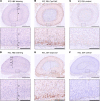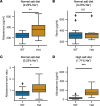Isradipine therapy in Cacna1dIle772Met/+ mice ameliorates primary aldosteronism and neurologic abnormalities
- PMID: 37698934
- PMCID: PMC10619505
- DOI: 10.1172/jci.insight.162468
Isradipine therapy in Cacna1dIle772Met/+ mice ameliorates primary aldosteronism and neurologic abnormalities
Abstract
Somatic gain-of-function mutations in the L-type calcium channel CaV1.3 (CACNA1D gene) cause adrenal aldosterone-producing adenomas and micronodules. De novo germline mutations are found in a syndrome of primary aldosteronism, seizures, and neurologic abnormalities (PASNA) as well as in autism spectrum disorder. Using CRISPR/Cas9, we here generated mice with a Cacna1d gain-of-function mutation found in both adenomas and PASNA syndrome (Cacna1dIle772Met/+). These mice show reduced body weight and increased mortality from weaning to approximately 100 days of age. Male mice do not breed, likely due to neuromotor impairment, and the offspring of female mice die perinatally, likely due to lack of maternal care. Mice generated by in vitro fertilization showed elevated intracellular calcium in the aldosterone-producing zona glomerulosa, an elevated aldosterone/renin ratio, and persistently elevated serum aldosterone on a high-salt diet as signs of primary aldosteronism. Anesthesia with ketamine and xylazine induced tonic-clonic seizures. Neurologic abnormalities included hyperlocomotion, impaired performance in the rotarod test, impaired nest building, and slight changes in social behavior. Intracellular calcium in the zona glomerulosa, aldosterone levels, and rotarod performance responded to treatment with the calcium channel blocker isradipine, with implications for the therapy of patients with aldosterone-producing lesions and with PASNA syndrome.
Keywords: Endocrinology; Hypertension; Mouse models; Neurological disorders; Neuroscience.
Figures









Similar articles
-
[The third case report a patient with primary aldosteronism, seizures, and neurologic abnormalities (PASNA) syndrome de novo variant mutations in the CACNA1D gene].Zh Nevrol Psikhiatr Im S S Korsakova. 2018;118(12):49-52. doi: 10.17116/jnevro201811812149. Zh Nevrol Psikhiatr Im S S Korsakova. 2018. PMID: 30698561 Russian.
-
Somatic and germline CACNA1D calcium channel mutations in aldosterone-producing adenomas and primary aldosteronism.Nat Genet. 2013 Sep;45(9):1050-4. doi: 10.1038/ng.2695. Epub 2013 Aug 4. Nat Genet. 2013. PMID: 23913001 Free PMC article.
-
Enhanced Ca2+ signaling, mild primary aldosteronism, and hypertension in a familial hyperaldosteronism mouse model (Cacna1hM1560V/+ ).Proc Natl Acad Sci U S A. 2021 Apr 27;118(17):e2014876118. doi: 10.1073/pnas.2014876118. Proc Natl Acad Sci U S A. 2021. PMID: 33879608 Free PMC article.
-
Novel genes in primary aldosteronism.Curr Opin Endocrinol Diabetes Obes. 2014 Jun;21(3):154-8. doi: 10.1097/MED.0000000000000060. Curr Opin Endocrinol Diabetes Obes. 2014. PMID: 24739312 Review.
-
CaV3.2 (CACNA1H) in Primary Aldosteronism.Handb Exp Pharmacol. 2023;279:249-262. doi: 10.1007/164_2023_660. Handb Exp Pharmacol. 2023. PMID: 37311830 Review.
Cited by
-
Therapeutic Potential of Calcium Channel Blockers in Neuropsychiatric, Endocrine and Pain Disorders.Cells. 2025 Jul 20;14(14):1114. doi: 10.3390/cells14141114. Cells. 2025. PMID: 40710367 Free PMC article. Review.
-
A Novel De Novo Gain-of-Function CACNA1D Variant in Neurodevelopmental Disease With Congenital Tremor, Seizures, and Hypotonia.Neurol Genet. 2024 Sep 6;10(5):e200186. doi: 10.1212/NXG.0000000000200186. eCollection 2024 Oct. Neurol Genet. 2024. PMID: 39246741 Free PMC article.
-
T- and L-Type Calcium Channels Maintain Calcium Oscillations in the Murine Zona Glomerulosa.Hypertension. 2024 Apr;81(4):811-822. doi: 10.1161/HYPERTENSIONAHA.123.21798. Epub 2024 Feb 16. Hypertension. 2024. PMID: 38507511 Free PMC article.
-
Expression and function of Connexin 43 and Connexin 37 in the murine zona glomerulosa.Physiol Rep. 2025 Feb;13(3):e70215. doi: 10.14814/phy2.70215. Physiol Rep. 2025. PMID: 39877942 Free PMC article.
-
The human channel gating-modifying A749G CACNA1D (Cav1.3) variant induces a neurodevelopmental syndrome-like phenotype in mice.JCI Insight. 2023 Oct 23;8(20):e162100. doi: 10.1172/jci.insight.162100. JCI Insight. 2023. PMID: 37698939 Free PMC article.
References
-
- NCD Risk Factor Collaboration (NCD-RisC) Worldwide trends in hypertension prevalence and progress in treatment and control from 1990 to 2019: a pooled analysis of 1201 population-representative studies with 104 million participants. Lancet. 2021;398(10304):957–980. doi: 10.1016/S0140-6736(21)01330-1. - DOI - PMC - PubMed

